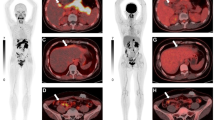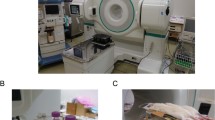Abstract
Purpose
The Eastern woodchuck (Marmota monax) is considered as a naturally occurring animal model of hepatocellular carcinoma (HCC). The performance of 2-deoxy-2-[F-18]fluoro-d-glucose (FDG) for imaging HCC on the woodchuck using Positron emission tomography (PET) was investigated in this study.
Procedures
Dynamic FDG-PET scans were performed on five woodchucks with HCC and one healthy woodchuck before removal and processing of the liver tissues for histology. The parameters of a two-tissue compartment model with dual input were estimated using weighted least squares (WLS).
Results
Ten HCCs were confirmed histologically. Six HCCs had a tumor-to-liver standardized uptake value (SUV) ratio ≤1.15, a k 4 / k 3 ratio similar to that in hepatic tissues and were well-differentiated. Four HCCs had a tumor-to-liver SUV ratio >1.15, a lower k 4 / k 3 ratio than the hepatic tissues and were moderately differentiated.
Conclusions
Increased FDG uptake was observed in HCCs that were the least differentiated and correlated with a lower k 4 / k 3 ratio.







Similar content being viewed by others
References
Parkin DM, Bray F, Ferlay J, et al. (2001) Estimating the world cancer burden: Globocan 2000. Int J Cancer 94:153–156
Merle P (2005) Epidemiology, natural history and pathogenesis of hepatocellular carcinoma. Cancer Radiother 9:452–457
Donato F, Tagger A, Gelatti U, et al. (2002) Alcohol and hepatocellular carcinoma: the effect of lifetime intake and hepatitis virus infections in men and women. Am J Epidemiol 155:323–331
Peers FG, Gilman GA, Linsell CA (1976) Dietary aflatoxins and human liver cancer. A study in Swaziland. Int J Cancer 17:167–176
Yeh FS, Yu MC, Mo CC, et al. (1989) Hepatitis B virus, aflatoxins, and hepatocellular carcinoma in southern Guangxi, China. Cancer Res 49:2506–2509
Tremolda F, Benevegnu L, Drago C, et al. (1989) Early detection of hepatocellular carcinoma in patients with cirrhosis by alphafetoprotein, ultrasound and fine-needle biopsy. Hepatogastroenterology 36:519–521
Teefey SA, Hildeboldt CC, Dehdashti F, et al. (2003) Detection of primary hepatic malignancy in liver transplant candidates: prospective comparison of CT, MR imaging, US, and PET. Radiology 226:533–542
Kudo M, Tomita S, Tochio H, et al. (1992) Small hepatocellular carcinoma: diagnosis with US angiography with intraarterial CO2 microbubbles. Radiology 182:155–160
Nguyen MH, Garcia RT, Simpson PW, et al. (2002) Racial differences in effectiveness of alpha-fetoprotein for diagnosis of hepatocellular carcinoma in hepatitis C virus cirrhosis. Hepatology 36:410–417
Cedrone A, Covino M, Caturelli E, et al. (2000) Utility of alpha-fetoprotein (AFP) in the screening of patients with virus-related chronic liver disease: does different viral etiology influence AFP levels in HCC? A study in 350 western patients. Hepatogastroenterology 47:1654–1658
Choi D, Kim SH, Lim JH, et al. (2001) Detection of hepatocellular carcinoma: combined T2-weighted and dynamic gadolinium-enhanced MRI versus combined CT during arterial portography and CT hepatic arteriography. J Comput Assist Tomogr 25:777–785
Tang Y, Yamashita Y, Arakawa A, et al. (1999) Detection of hepatocellular carcinoma arising in cirrhotic livers: comparison of gadolinium- and ferumoxides-enhanced MR imaging. AJR Am J Roentgenol 172:1547–1554
Fujita T, Ito K, Honjo K, et al. (1999) Detection of hepatocellular carcinoma: comparison of T2-weighted breath-hold fast spin-echo sequences and high-resolution dynamic MR imaging with a phased-array body coil. J Magn Reson Imaging 9:274–279
Krinsky G (2004) Magnetic resonance imaging of hepatocellular carcinoma. Proceedings of the NIH Workshop on hepatocellular carcinoma: screening, diagnosis, and management. 103–108
Jeng LB, Changlai SP, Shen YY, et al. (2003) Limited value of 18F-2-deoxyglucose positron emission tomography to detect hepatocellular carcinoma in hepatitis B virus carriers. Hepatogastroenterology 50:2154–2156
Khan MA, Combs CS, Brunt EM, et al. (2000) Positron emission tomography scanning in the evaluation of hepatocellular carcinoma. J Hepatol 32:792–797
Oya N, Nagata Y, Tamaki N, et al. (1996) FDG-PET evaluation of therapeutic effects on VX2 liver tumor. J Nucl Med 37:296–302
Habermann RT, Williams FP Jr, Eyestone WH (1954) Spontaneous hepatomas in two woodchucks and a carcinoma of the testis in a badger. J Am Vet Med Assoc 125:295–298
Snyder R (1968) Hepatomas of captive woodchucks. Am J Pathol 52:32A–33A
Tennant BC, Toshkov IA, Peek SF, et al. (2004) Hepatocellular carcinoma in the woodchuck model of hepatitis B virus infection. Gastroenterology 127:S283–S293
Goldberg BB, Liu JB, Burns PN, et al. (1993) Galactose-based intravenous sonographic contrast agent: experimental studies. J Ultrasound Med 12:463–470
Forsberg F, Liu JB, Merton DA, et al. (1995) Parenchymal enhancement and tumor visualization using a new sonographic contrast agent. J Ultrasound Med 14:949–957
Ohtomo K, Shiga J, Sasaki Y, et al. (1991) Iron oxide-enhanced MR imaging of hepatocellular carcinoma of woodchuck. Nippon Igaku Hoshasen Gakkai Zasshi 51:433–435
Qiu W, David D, Zhou B, et al. (2003) Down-regulation of growth arrest DNA damage-inducible gene 45beta expression is associated with human hepatocellular carcinoma. Am J Pathol 162:1961–1974
Phelps ME, Huang SC, Hoffman EJ, et al. (1979) Tomographic measurement of local cerebral glucose metabolic rate in humans with (F-18)2-fluoro-2-deoxy-d-glucose: validation of method. Ann Neurol 6:371–388
Muzic RF Jr, Cornelius S (2001) COMKAT: compartment model kinetic analysis tool. J Nucl Med 42:636–645
Shibata T, Yamamoto K, Hayashi N, et al. (1988) Dynamic positron emission tomography with 13N-ammonia in liver tumors. Eur J Nucl Med 14:607–611
Lee JD, Yun M, Lee JM, et al. (2004) Analysis of gene expression profiles of hepatocellular carcinomas with regard to 18F-fluorodeoxyglucose uptake pattern on positron emission tomography. Eur J Nucl Med Mol Imaging 31:1621–1630
Trojan J, Schroeder O, Raedle J, et al. (1999) Fluorine-18 FDG positron emission tomography for imaging of hepatocellular carcinoma. Am J Gastroenterol 94:3314–3319
Delbeke D, Martin WH, Sandler MP, et al. (1998) Evaluation of benign vs malignant hepatic lesions with positron emission tomography. Arch Surg 133:510–515; discussion 515–516
Torizuka T, Tamaki N, Inokuma T, et al. (1995) In vivo assessment of glucose metabolism in hepatocellular carcinoma with FDG-PET. J Nucl Med 36:1811–1817
Yu K, Schomisch SJ, Chandramouli V, et al. (2006) Hexokinase and glucose-6-phosphatase activity in woodchuck model of hepatitis virus-induced hepatocellular carcinoma. Comp Biochem Physiol C Pharmacol Toxicol 143:225–231
Acknowledgment
We gratefully thank Joseph Molter, Gautam Desai, Jordan Dale, Anthony Megellini, and Maxwell Kotlarchyk for their kind support. We also acknowledge the laboratory animal contributions of Marmotech Inc. in the studies. This work was supported in part by the National Institute of Health (NIH CA095307).
Author information
Authors and Affiliations
Corresponding author
Rights and permissions
About this article
Cite this article
Salem, N., MacLennan, G.T., Kuang, Y. et al. Quantitative Evaluation of 2-Deoxy-2[F-18]fluoro-d-glucose-Positron Emission Tomography Imaging on the Woodchuck Model of Hepatocellular Carcinoma with Histological Correlation. Mol Imaging Biol 9, 135–143 (2007). https://doi.org/10.1007/s11307-007-0092-5
Published:
Issue Date:
DOI: https://doi.org/10.1007/s11307-007-0092-5




